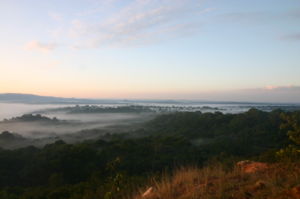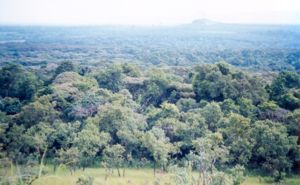
Kakamega Forest
Encyclopedia


Kenya
Kenya , officially known as the Republic of Kenya, is a country in East Africa that lies on the equator, with the Indian Ocean to its south-east...
, north-west of the capital Nairobi
Nairobi
Nairobi is the capital and largest city of Kenya. The city and its surrounding area also forms the Nairobi County. The name "Nairobi" comes from the Maasai phrase Enkare Nyirobi, which translates to "the place of cool waters". However, it is popularly known as the "Green City in the Sun" and is...
, and near to the border with Uganda
Uganda
Uganda , officially the Republic of Uganda, is a landlocked country in East Africa. Uganda is also known as the "Pearl of Africa". It is bordered on the east by Kenya, on the north by South Sudan, on the west by the Democratic Republic of the Congo, on the southwest by Rwanda, and on the south by...
. It is said to be Kenya's last remnant of the ancient Guineo-Congolian rainforest that once spanned the continent.
Including reserves, the forest encloses about 230 square kilometres, a little less than half of which currently remains as indigenous forest. There are numerous grassy clearings and glades. Large mammals are rare. Part of the forest also contain unique and rich highland
Highland (geography)
The term highland or upland is used to denote any mountainous region or elevated mountainous plateau. Generally speaking, the term upland tends to be used for ranges of hills, typically up to 500-600m, and highland for ranges of low mountains.The Scottish Highlands refers to the mountainous...
ecosystems, but generally the fauna and flora of the Forest have not been comprehensively studied by science. The climate is very wet with over two metres of rain annually. The rainy seasons are April-to-May and August-to-September.
In the north of the Forest is the 4468 ha (45 km²; 17 sq mi) Kakamega National Reserve, given national forest reserve status in 1985. Just to the north is the Kisere Forest Reserve. Despite having protected status the Forest has continued to be damaged and degraded. The Forest Department and the Kenya Wildlife Service work to protect the forest. The local inhabitants are the Luhya people, who rely on the forest to supply most of their needs. The region is said to be one of the most densely-populated rural areas in the world, and pressure on the Forest resources is considerable. The German funded project BIOTA East has been working in the forest since 2001, whereby firstly forest inventories for all sorts of life forms were performed and the aim is to find strategies for a sustainable use of the forest until 2010.
The major A1 road runs down the western edge of the area.

